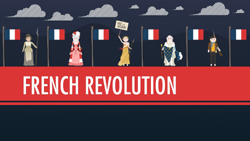| The year 1789 witnessed two far-reaching events:
The beginning of a new United States of America and the beginning of the
French Revolution. Compared with the American Revolution, the French
Revolution was more complex and more radical. The French Revolution
established both a new political order and a new social order. For
that reason, it is considered a turning point in European history.
Background to the Revolution
-
The Third Estate, the vast majority of the French people,
was heavily taxed and discontented.
France’s Three Estates
Since the Middle Ages, France’s population had been divided
by law into one of three status groups, or social classes—the three
estates.
The Three Estates
The First Estate – the Clergy
The Second Estate – the Nobility
The Third Estate – Everyone Else, from lowly peasants
to wealthy merchants.
taille
taxes
The First and Second Estates did not have to pay the taille—only
the Third Estate bore that burden.
The First Estate, the Clergy, included all the monks and
nuns, priests, bishops, and cardinals of the Catholic Church, While
many were poor, some members of the Church were fabulously wealthy.
None of the Clergy paid the taille.
The Second Estate, the Nobility owned from 25 to 30 percent
of all the land in France. The Nobility held high positions in government
and the military. The Nobility did not pay taxes.
Bourgeoisie
The middle class—including merchants, bankers, industrialists,
doctors, lawyers, writers, public officers and elected officials—all part
of the Third Estate.
King Louis XVI
The absolute monarch of France, whose word was law.
His wife, the queen, was the Austrian princess Marie
Antoinette.
Financial Crisis
By 1789. France was on the verge of financial collapse
due to bad harvests across the land, slowdown in manufacturing, rising
food prices, severe unemployment, and heavy debts incurred helping the
American colonies gain independence.
At the same time, the French king and his ministers,
as well as Marie Antoinette, continued to spend huge amounts on court luxuries.
In order to raise taxes to pay these debts and continue
their lavish lifestyle, King Louis XVI was forced to call a meeting of
the Estates-General. The Estates-General had not met since 1614,
due to the absolute power of the French kings.
REVIEW & DO
NOW
Answer the following questions in your spiral notebooks: |
List and describe the three main social classes in France.
Which of them paid taxes?
Who were the Bourgeoisie?
What estates did they belong to?
Who were the king and queen of France in 1789?
What was the situation in France like at the time? |
Why did King Louis XVI decide to raise taxes?
What was the king forced to do in order to raise taxes?
At the time, did France have a Bill of Rights, a written
Constitution, or a functioning Parliament?
When was the last time the Estates-General had convened?
Why had they not met in so long? |
|
|
Louis XVI called a meeting of the Estates-General
on May 5, 1789.
From Estates-General to National Assembly
-
The Third Estate claimed the right to have its votes count
as much as those of the First and Second Estates.
The goal of the Third Estate was to set up a Constitutional
Government that would require the Clergy and Nobility pay taxes, too.
But the way voting was traditionally set up, the First
and Second Estate together could outvote the Third Estate 2-to-1.
The king refused to allow the Third Estate to have a greater
voice in the assembly.
On June 17, 1789 the Third Estate declared itself
to be the National Assembly and would draft a new constitution. Three
days later, deputies of the Third Estate returned to their meeting place,
only to find the doors had been locked.
Tennis Court Oath
Locked out of the assembly, the Third Estate met in a
nearby indoor tennis court and swore an oath that they would continue meeting
until they had drafted a new constitution.
The Storming of the Bastille:
King Louis XVI prepared to use force against the Third
Estate.
On July 14, 1789, a Paris mob stormed the Bastille—a
fortress which had once held prisoners but was now an armory holding munitions—and
destroyed it, beheading the warden.
Riots broke out all over France.
The Great Fear
As riots against the inequality continued, fear grew
that foreign countries would invade France to restore order and punish
the people.
Mobs broke into the houses of lords to destroy the records
of the debts the common people owed.
REVIEW & DO
NOW
Answer the following questions in your spiral notebooks: |
| What right did the Third Estate claim in the meeting
of the Estates-General?
Where did the representatives of the Third Estate meed
when they were locked out of the assembly?
What was the 'Tennis Court Oath?
What was King Louis willing to do to remove them?' |
What happened on July 14, 1789 in Paris? It is
an event celebrated in France to this day.
What were the riots about?
What was one of the actions of the mobs? |
|
|
End of the Old Regime
-
The National Assembly affirmed the “Rights of Man” and set
up a limited monarchy in the Constitution of 1791.
On August 4, 1789, the National Assembly abolished all legal
privileges of the nobles and clergy.
Declaration of the Rights of Man
Adopted by the National Assembly on August 26,
it was inspired by the English Bill of Rights of 1689 and the US Declaration
of Independence and its Constitution.
Declaration of the Rights of Man and the Citizen
This charter recognized the “natural and imprescriptible
rights of man” to “liberty, property, security, and resistance to oppression.”
Reflecting Enlightenment thought, the Declaration of the
Rights of Man and the Citizen proclaimed that all men were free and equal
before the law, that appointment to public office should be based on talent,
and that no group should be exempt from taxation. It also recognized
the freedom of speech and freedom of the press.
But the Assembly literally meant only men. Women
were excluded from these considerations.
Olympe de Gouges composed a Declaration of
the Rights of Woman.
The King Concedes
Used to being the absolute ruler, King Louis XVI remained
at Versailles and refused to recognize the National Assembly’s decrees.
On October 5, thousands of Parisian women, armed with
brooms, pitchforks, swords, pistols, and muskets, marched on the palace
and demanded an audience with the king. Telling Louis their children
were starving, they forced him to accept the Declaration.
They demanded the king and queen come to Paris because
they did not trust him. King Louis XVI and Marie Antoinette became
prisoners of the people.
Church Reforms
The National Assembly seized assets of the Catholic Church
and began selling off Church-owned lands, raising money for the national
treasury.
The Assembly passed the Civil Constitution of the Clergy.
In the new law, the National Assembly determined that
bishops and priests would be elected by the people, not appointed by the
pope. Their salaries would be paid by the government.
Because of these changes, many Catholics opposed the revolution.
New Constitution and New Fears
The new Constitution of 1791 set up a limited monarchy.
There was still a king, but a Legislative Assembly would make the laws.
It was designed to be conservative. Only active
citizens—men over 25 who paid a certain amount of taxes—could vote.
Only relatively wealthy people could serve on the Assembly. Government
officials and judges would be elected Local governments were put
in charge of taxation.
Although the “Ancien Regime” had been destroyed, not everyone
supported the new government. Political radicals and the poor wanted
more reform.
In June, 1791, the king and his family attempted to flee
France in disguise. He was captured trying to escape to Austria,
and he and his family were returned to Paris. The Constitution was amended
so that if he tried to escape again, he could be tried for treason.
War with Austria
Some European leaders began to fear the revolution would
spread to their countries. Prussia and Austria threatened to use
force to restore King Louis XVI to full power.
The Legislative Assembly decided to strike first—declaring
war on Austria in the spring of 1792.
Things did not go well for France.
Rise of the Paris Commune
In the spring of 1792, angry citizens demonstrated to
protest food shortages and defeat in the war.
Paris radicals declared themselves a commune, the
Paris
Commune—a city council run on direct democratic (poular)
vote—and attacked the Legislative Assembly.
Members of the Paris Commune took the king prisoner.
They forced the Legislative Assembly to suspend the monarchy and call for
a National Convention. They wanted all males to have the right to
vote.
Members of the Paris Commune called themselves sans-culottes.
sans-culottes
meaning “without breeches” (britches)
These members wore long pants, instead of the knee-length
breeches of the nobility. This identified them as ordinary patriots,
without the fine clothes of the wealthy.
The Paris Commune was not made up entirely of working
people and the poor—many were merchants and artisans, the elite of their
neighborhood.
The revolution was entering a more radical phase, as foreign
governments threatened to intervene and economic conditions showed little
improvement.
REVIEW & DO
NOW
Answer the following questions in your spiral notebooks: |
What was the Declaration of the Rights of Man and Citizen,
and what did it do?
When was it adopted?
What was a major problem with the Declaration, regarding
50% of the French population?
What did the Constitution of 1791 do with France's monarchy?
According to this new constitution, who could vote?
Who could hold office in the Assembly? |
What did the king do in June of 1791?
What was done to the Constitution in response?
What were Prussia and Austria threatening to do to France?
—What was the National Assembly's response, in the spring
of 1792?
What was the Paris Commune?
What did the members call themselves?
What kind of were members?
What did the Paris Commune do with the king and the monarchy
itself? |
|
|
|





